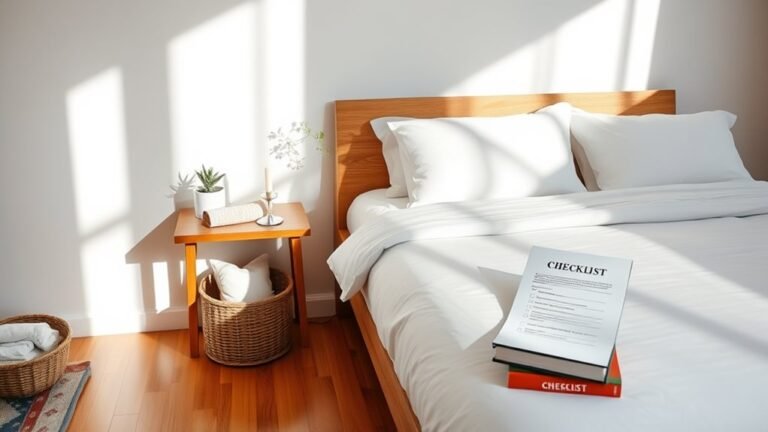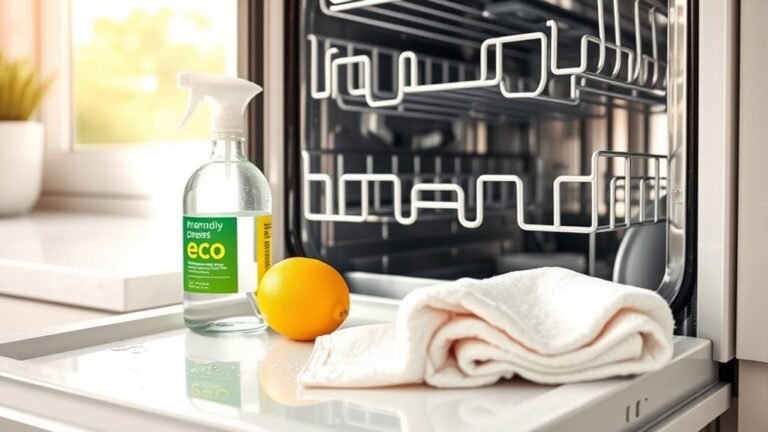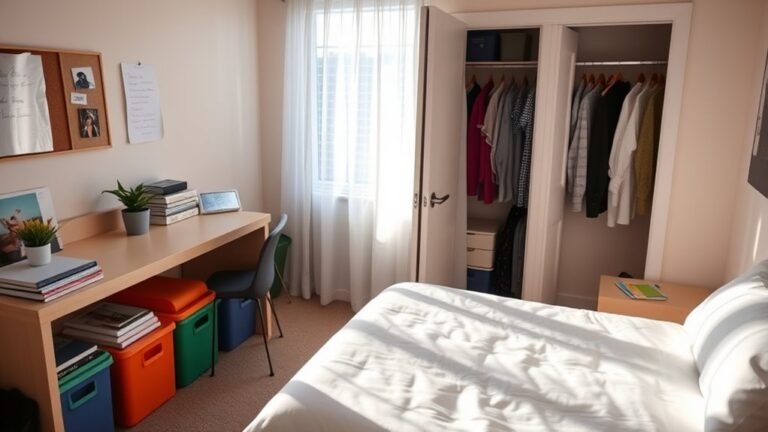Cleaning Mistakes That Damage Your Baseboards
You’re damaging your baseboards if you use harsh chemicals, scrub too hard, or pour on too much water—these can cause discoloration, warping, or finish wear. Skipping regular dusting lets dirt build up, making stains harder to remove later. Using the wrong tools or neglecting stubborn stains only worsens the damage. Protecting your baseboards means gentle cleaning and timely care. Keep these tips in mind, and you’ll avoid common pitfalls while preserving your baseboards’ look and longevity.
Using Harsh Chemicals on Baseboards
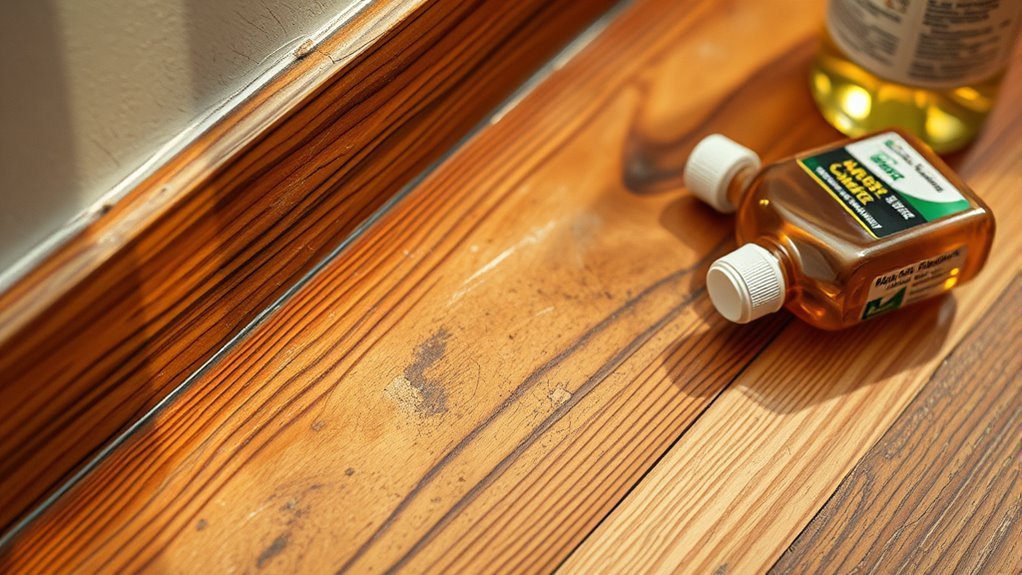
Although harsh chemicals might seem effective, using them on your baseboards can cause lasting damage. You want your baseboards to stay beautiful, not weakened by unseen chemical reactions. Many baseboard materials—like wood, MDF, or painted surfaces—react differently to strong cleaners. When you apply harsh chemicals, you risk discoloration, warping, or even erosion of the finish. This limits your freedom to maintain a clean, inviting home without worrying about costly repairs or replacements. Instead, choosing gentle, pH-balanced solutions respects the integrity of your baseboards, ensuring they last longer and look great. You don’t have to sacrifice your freedom to a spotless home by damaging what keeps your space framed and polished. Be smart, choose safer cleaning options, and preserve your baseboards’ strength.
Scrubbing Too Vigorously
While choosing gentle cleaners helps protect your baseboards from chemical damage, how you clean them matters just as much. Scrubbing too vigorously can wear down the finish or even chip the paint, especially depending on the baseboard material. Whether you have wood, MDF, or vinyl, aggressive scrubbing can leave scratches or dents that ruin the smooth look you want. Instead, adopt a scrubbing technique that’s firm but gentle—using a soft cloth or a non-abrasive sponge is key. Let your cleaning solution do the heavy lifting, and avoid pressing too hard. By respecting the baseboard material and adjusting your scrubbing approach, you keep your baseboards looking fresh and intact without sacrificing your freedom to clean effectively.
Ignoring Regular Dusting and Cleaning

If you skip regular dusting, dirt can build up and cause your baseboards to look dull or even get damaged over time. Keeping up with routine cleaning not only protects them but also keeps your space looking fresh. You’ll find that a little effort regularly goes a long way in maintaining their appearance.
Dust Accumulation Effects
When you skip regular dusting, dust quickly builds up on your baseboards, causing them to look dull and dirty. This dust particle accumulation isn’t just unsightly—it can lead to bigger problems. Over time, the layer of dust creates an inviting environment for dust mite infestations, which can affect your indoor air quality and trigger allergies. If you want to keep your space feeling open and fresh, letting these particles settle unchecked only limits that freedom. Plus, the longer dust sits, the harder it is to clean, potentially damaging the paint or finish on your baseboards. Staying on top of dust buildup helps you maintain a clean, healthy environment without feeling trapped by constant deep cleaning sessions.
Benefits of Routine Cleaning
Even though it might seem tedious, sticking to a routine cleaning schedule for your baseboards saves you time and effort in the long run. When you commit to regular maintenance, you prevent dirt and grime from building up, which can lead to costly damage. Skipping routine maintenance often means dealing with stubborn stains and scratches that require intense scrubbing or even repairs. By integrating simple cleaning tasks into your schedule, you keep your baseboards looking fresh and avoid unnecessary wear. This approach gives you more freedom to enjoy your space without the stress of overwhelming chores. Fundamentally, a consistent cleaning schedule protects your investment and keeps your home feeling inviting, all while making your cleaning routine smoother and less time-consuming.
Using Excessive Water During Cleaning
Although water is essential for cleaning, using too much of it can cause serious damage to your baseboards. Excess moisture seeps into the wood, leading to swelling, warping, and even mold growth. To enjoy freedom in your home without the hassle of repairs, balance your cleaning frequency with careful water use.
| Cleaning Frequency | Water Used | Risk of Damage |
|---|---|---|
| Daily | Minimal | Low |
| Weekly | Moderate | Medium |
| Monthly or Less | Excessive | High (Water Damage) |
Stick to damp cloths rather than soaking your baseboards. This reduces water damage risks and keeps your baseboards looking fresh without limiting your cleaning freedom.
Neglecting to Protect Baseboards During Renovations
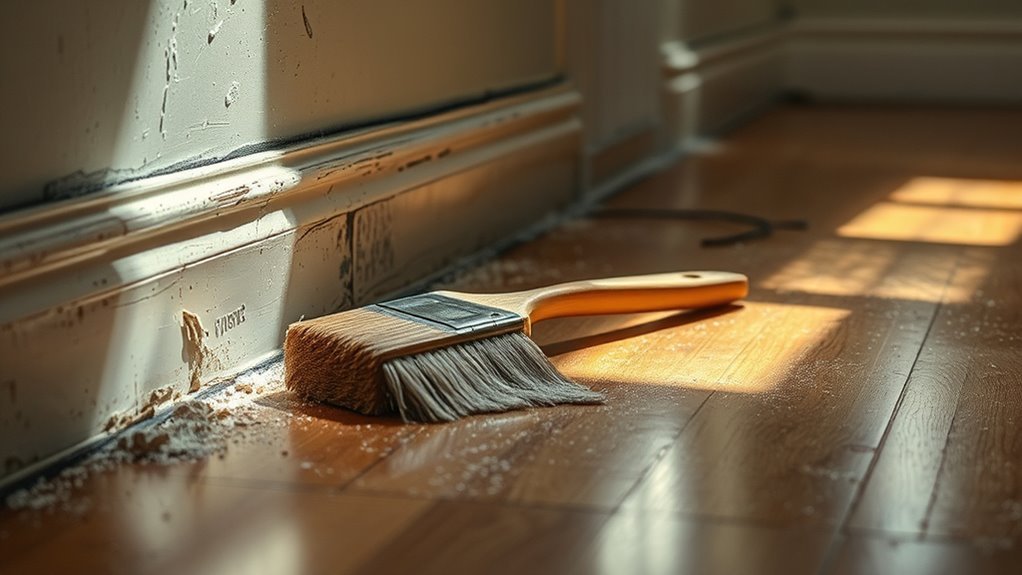
Water damage isn’t the only threat to your baseboards; renovations can cause serious harm if you don’t take steps to protect them. When you’re remodeling, renovation debris like dust, paint splatters, and stray nails can easily damage or stain your baseboards. If you skip using protective coverings, you leave your baseboards exposed to scratches, dents, and permanent marks. It’s tempting to rush renovations without thinking about these details, but taking a few extra minutes to cover your baseboards with plastic sheets or painter’s tape can save you from costly repairs later. Protecting your baseboards during renovations isn’t just about preserving appearance—it’s about maintaining your freedom to enjoy a clean, damage-free home without extra hassle after the work is done.
Applying Inappropriate Cleaning Tools
One common mistake people make is using the wrong tools to clean their baseboards. Picking inappropriate tools can cause scratches, chips, or wear down the finish, limiting your freedom to enjoy a flawless look. To keep your baseboards pristine, use these appropriate tools and cleaning techniques:
- Soft microfiber cloths instead of rough sponges or brushes.
- Gentle scrub brushes with soft bristles for stubborn dirt.
- A vacuum with a brush attachment to remove dust without damage.
- Mild, non-abrasive cleaning solutions that won’t strip paint or varnish.
Overlooking Stubborn Stains Until They Set
If you ignore stubborn stains on your baseboards, they can become much harder to remove over time. Catching these marks early makes cleaning simpler and prevents permanent damage. Waiting too long can cause discoloration or require harsh scrubbing that harms the finish.
Identifying Persistent Stains
How do you know when a stain on your baseboards has become permanent? Recognizing persistent stains is key to preserving your freedom from costly repairs. For effective stain identification, watch for these signs:
- The stain remains visible after regular cleaning.
- It darkens or changes texture over time.
- Attempts to remove it require harsh scrubbing.
- It spreads or appears embedded in the material.
Once you spot these, it’s clear the stain has set. Don’t ignore it—knowing when a stain is persistent lets you choose effective solutions before damage worsens. Taking swift, informed action frees you from ongoing frustration and protects your baseboards’ appearance and longevity. Trust your judgment, and tackle those stubborn stains head-on.
Timing of Stain Removal
Though it might be tempting to delay cleaning stubborn stains on your baseboards, waiting too long can turn minor marks into permanent damage. Mastering timing techniques is essential for effective stain removal and preserving your baseboards’ look. When you spot a stubborn stain, act quickly—stains become tougher to remove as they set deeper into the material. Using the right timing techniques means you avoid scrubbing too hard or too late, which can cause wear or discoloration. By addressing stains promptly, you keep your baseboards looking fresh and avoid costly repairs. Don’t let procrastination steal your freedom to enjoy a clean, beautiful space—timely stain removal is your best defense against lasting damage.
Effects of Delay
Waiting too long to tackle stubborn stains on your baseboards can lead to problems beyond just tough cleaning sessions. When you delay maintenance, stains set deeper, making removal a real challenge. This procrastination often causes:
- Permanent discoloration that cheapens your space.
- Increased wear from aggressive scrubbing attempts.
- Accumulation of dirt leading to structural weakening.
- Long term damage that demands costly repairs or replacements.
You want your home to feel open and fresh, not trapped by neglect. Address stains quickly to maintain your baseboards’ integrity and keep your cleaning routine simple. Freedom from stubborn grime starts with timely action—don’t let delayed maintenance chain you to unnecessary work or expense.
Frequently Asked Questions
How Do I Repair Chipped Paint on Baseboards?
If you’ve got chipped paint on your baseboards, here’s how to handle baseboard repair. First, gently sand the chipped area to smooth it out. Then, wipe away dust and apply a primer to help the new paint stick. Once dry, paint over the spot with matching paint. You’re free to do this at your own pace, and soon your baseboards will look fresh without any hassle or stress.
What Is the Best Paint Finish for Baseboards?
When picking paint, you want a finish that’s both fabulous and functional. While a matte finish may feel free-spirited and subtle, it can scuff and stain easily on baseboards. A glossy finish, on the other hand, offers a sleek shine and sturdy surface that’s easier to wipe clean—perfect if you crave carefree cleaning and lasting looks. So, go for glossy if you want baseboards that stand strong and sparkle.
Can Baseboards Be Safely Cleaned With a Steam Cleaner?
You can use a steam cleaner on baseboards, but you’ll want to evaluate the material first. Steam cleaning advantages include deep cleaning and sanitizing without harsh chemicals, which is great for freedom from toxins. However, if your baseboards are made of wood or have delicate finishes, the heat and moisture might cause damage. So, always test a small area or opt for gentler methods to keep your baseboards safe and looking fresh.
How Often Should Baseboards Be Repainted or Refinished?
You should follow a repainting frequency guide to keep your baseboards looking fresh without overdoing it. Generally, repainting every 3-5 years works well, but it depends on wear and tear. For easy baseboard maintenance tips, regularly dust and spot clean to extend the paint’s life. This way, you’ll enjoy clean, sharp baseboards while feeling free from constant upkeep stress.
Are There Eco-Friendly Cleaning Products for Baseboards?
Wondering if eco-friendly cleaning products exist for your baseboards? They absolutely do! You don’t have to settle for harsh chemicals. With natural cleaning options and simple DIY solutions—like vinegar, baking soda, and lemon juice—you can refresh your baseboards safely and effectively. These choices give you freedom from toxins while keeping your home sparkling clean. So, why not embrace a greener, safer way to care for your space?

